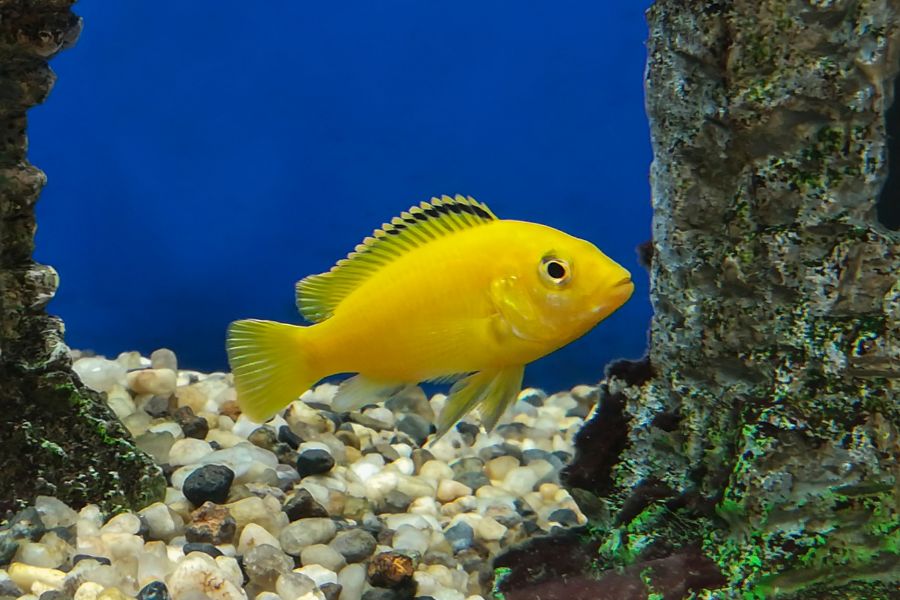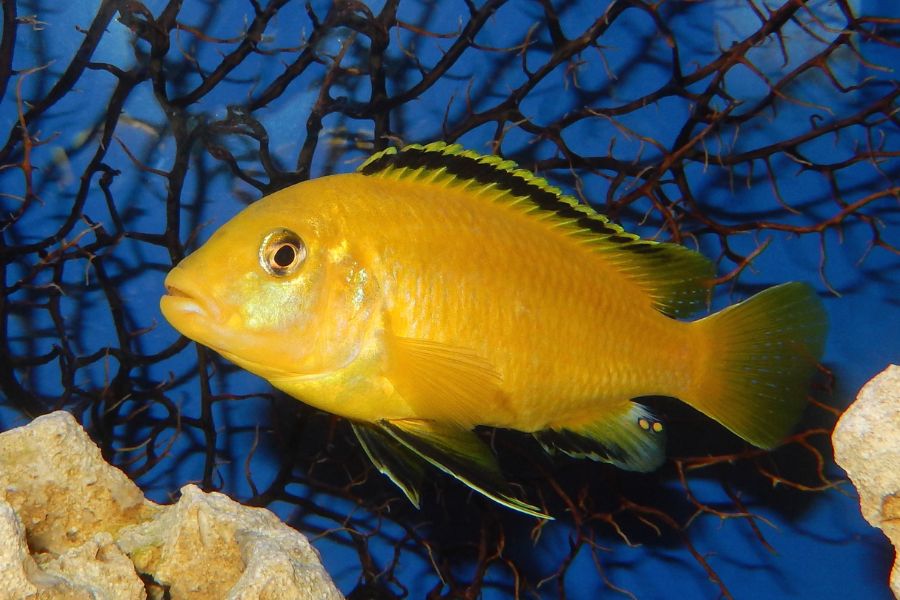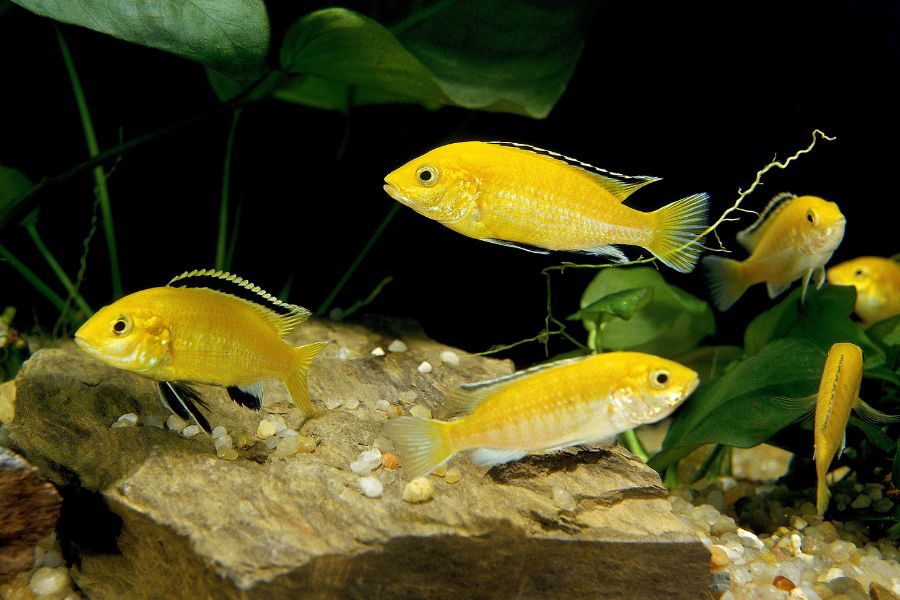The yellow lab cichlid (Labidochromis caeruleus) is ranked as the best & most popular African cichlid among aquarium hobbyists.
The incredibly attractive yellow lab cichlids are also some of the easiest cichlids to take care of if you have a little aquarium experience.
You want to keep an eye on the pH when caring for the yellow labs. They prefer more alkaline waters than other cichlids due to the nature of their origin in Lake Malawi and other parts of East Africa.
Read on to learn all the important facts about yellow lab cichlids. Get to know their origin and physical characteristics. All you need to know to carefully and successfully care for the gorgeous species is outlined in detail below.
Yellow Lab Cichlids Overview
Short Summary on Yellow Lab Cichlids and their habitats:
| Names | Yellow Lab Cichlids (Labidochromis caeruleus)
Also known as the yellow African cichlid, Lemon drop cichlid, Electric yellow cichlid, Electric yellow Lab, Mbuna cichlid, lemon yellow labidochromis |
| Origins and Reginal Distribution | Originated from Lake Malawi and other regions of East Africa and Burundi |
| Tank Size | 55 gallons Minimum for a community
30 gallons minimum for less than six yellow labs 100 gallons minimum for adults and breeding purposes |
| Water Hardness Conditions | 18 – 20 dGH |
| Ideal Tank Mates | Less aggressive and equal sized fish. Thrives with other cichlids like Jewel cichlids, the Kribensis cichlid, Zebra cichlids, and strawberry peacock cichlids. |
| Average Size | 3– 5 inches, more than 5 inches in the ideal environment |
| Colors | Bright yellow with black-tipped dorsal fins |
| Lifespan | Typically, 5 years, but can live up to 10 years in the ideal environment |
| Diet | Omnivorous diet – vegetables are preferred |
| Optimal pH levels | 8.0 – 8.8 |
| Optimal Temperature | 75 – 80 degrees Fahrenheit |
The Yellow Lab cichlid is short for ‘Yellow Labidochromis Cichlid .’It was first discovered in the early 1980s along the regions of Burundi. Today, the species is widely distributed throughout Lake Malawi and other close regions like the Charo and Mbowe islands.
The species is known for its habit of living on rocks, contrary to what other similar cichlids prefer, which is soft sandy surfaces. They also stand out because of how socialized they are, unlike other cichlids like the Severum cichlids, which are solitary.
The name ‘Electric yellow cichlid’ comes from the bright, electrifying coloration of the fish and has nothing to do with electrical properties.
Yellow labs are part of the Mbuna cichlids species native to Lake Malawi and many nearby areas. They are called Mbuna, which natively means rock dweller, which symbolizes the habit of yellow labs to dwell on rocky surfaces at the bottom of the water. Their natural habitat is deep rocky waters.
Lifespan
The lifespan of the yellow lab is not so different from other cichlids. You can typically expect the animal to live for about 5 years.
However, the electric yellow labs have been known to live up to 10 years in an ideal environment in their natural habitat.
Appearance: Types, Shape, Colors & Size
Unlike the Severum cichlid, yellow labs have one unique color (provided they are in great health and natural genetics are at play).
The fish is decorated with a bright yellow body with dorsal fins with black tips. The colors get more intense as they age, but the color distribution remains the same.
The typical size of a yellow lab cichlid is 3 – 5 inches. The species can get an inch bigger when in their ideal natural environment in the wild. It is also important to note that the males are bigger and grow longer to about 6 inches.
The yellow lab cichlid growth rate is fast. The species grows to about half its size in about three months. That is 1.5 – 3 inches in 3 months.
Behaviors
So, can a yellow lab cichlid live alone? This species can survive alone for very long years, but it is advisable to keep it in the company of its own kind. A good community tank ratio is keeping one yellow lab cichlid male with two female counterparts.
Even though the company is great for them, please ensure the males are few because they can get very aggressive around each other. This is one of the signs of how the yellow labs have complex social structures.
They are known to engage in sexual behavior like kissing (nipping) and flirting (shaking tails and fins). They also have a hierarchical social structure where the most dominant male gets to mate with most females. This contributes to more competition and aggression in the community.
Apart from their social nature, yellow labs tend to stay at the bottom on rocky and décor. Caves and decor are great for breeding and bringing out the fish’s natural behavior.
Yellow Lab Cichlid Care Guide
You won’t need much to create a thriving environment for electric yellow cichlids. Most of what you will have to do to ensure their success is to keep the right tank mates, give them enough space, and avoid overfeeding.
Tank Size & Environment
Yellow labs thrive in a community tank with their fellow cichlids. The best tank size for a small batch is 55 gallons. You can opt for as little as 30 gallons if you keep two or three males who won’t breed.
However, for breeding purposes and if you are planning on growing the fish for longer, a tank of at least 100 gallons is recommended. You also want to include a lot of sight blocks and hiding spaces to protect the cichlids and other fish that share the community tank.
Yello labs love rocks and décor in their surroundings. Try to pick out the decorations that best simulate their natural habitat. This will reduce stress and ensure the cichlids thrive in a more comfortable environment.
Like other cichlids, the yellow labs produce a lot of biowastes. African cichlids, in general, are messier than your average community tank fish – they eat more and produce more waste.
A good test kit and filtration system are key in this aspect. You can start by ensuring a weekly 25% water change to counter the high feeding rate and pheromone excretion from the fish.
A canister filter or sump filter can handle the huge biowaste. It would be best if you also kept the yellow labs in higher stock to ensure they live more peacefully and thrive as they would in their natural habitat.
Tank Mates
Tank Mates are plenty for such a peaceful cichlid. Please keep in mind that they are peaceful in comparison to other cichlids but are more aggressive than your usual community fish. With that in mind, keep the yellow lab cichlids with similar semi-aggressive fish.
What you want to stay clear of are much bigger and more aggressive fish like the flower horn, angelfish, bettas, and discus.
Many cichlids can go with the yellow lab cichlid. These range from the popular rainbow cichlids to the featherfin cichlids.
The best yellow lab cichlid tank mates include:
- Jewel cichlids
- Kribensis cichlid
- Zebra cichlids
- Strawberry peacock cichlids
- Rainbow sharks
- Neon Blue Acera cichlid
- Rusty cichlids
- Featherfin cichlid
- Yellow tail acei cichlids
- Blue dolphin cichlids
- Red fin boreyli
- Clown loach
- Pleco
- Paratilapia
- Siamese algae eater
Water Quality & Water Parameters
The stability of the water parameters is more important than attaining the ideal conditions. Use the below ranges to keep your yellow labs stable to avoid any stress or shock.
Also, remember that the ideal parameters change when the cichlids start to breed; more on that later on.
- Water Temperature: 75 – 80 degrees Fahrenheit
- pH level: above, 7.8, ideal is between 8.0 – 8.8
- Water hardness: semi-hard between 18 – 20 DH
- Lighting: Dim lighting
- Ammonia, nitrate, nitrite levels: 0 PPM
Yellow Lab Cichlid Diet
Yellow labs eat a lot of vegetables. They prefer and thrive on a heavy veggie diet. Try the veggie spirulina flakes for the best cichlid nutrition. Pellet-based diets, including the Northfin Veggie pellets, are also great.
Algae that accumulates at the bottom of the tank is part of the cichlids’ diet. These fish have a habit of scavenging for foods at the bottom, from accumulated algae to food pellets and leftovers.
Best foods for yellow lab cichlids also entail color-enhancing commercial delicacies that bring out their bright, attractive yellow color.
Please ensure to keep the diet mostly vegetables since a high protein diet causes Malawi bloat, a condition that can be made worse with poor water quality and stress.
Yellow labs are active eaters who will feast on anything provided the food is available. It is important to ensure they do not bloat or become obese because it can happen very quickly if you overfeed them.
Insects and algae seem to be the cichlid’s natural diet in the wild. This greatly affects how much external food you should introduce into the tank.
If you feed them prepared foods like Spirulina, the yellow labs can also proceed to eat the large algae at the bottom and bloat. Limit your feeding schedule according to the naturally available food in the tank.
Breeding
Yellow labs are ovophiles. Ovophiles are types of cichlids that reproduce by mouthbrooding and digging holes where the eggs are laid.
The process starts when the cichlids dig pits where the female lays her eggs. The male is the one who digs the hole, and he can only do that if he has marked his territory away from other competing male yellow labs.
The eggs are then taken by the female yellow lab and placed into her mouth (buccal cavity), where they remain for up to 21 days. It is during this period that the eggs get fertilized by the male. You may be asking, how does that happen?
Before we answer that, you have to know how you can tell if a yellow lab cichlid is male or female. It is harder to tell the sex when the cichlids are just juveniles, but the distinctions become clearer when they are older.
Male cichlids are not only bigger than their female counterparts, but the most dominant males will also have more intense colors. However, this can be harder to identify in some tanks.
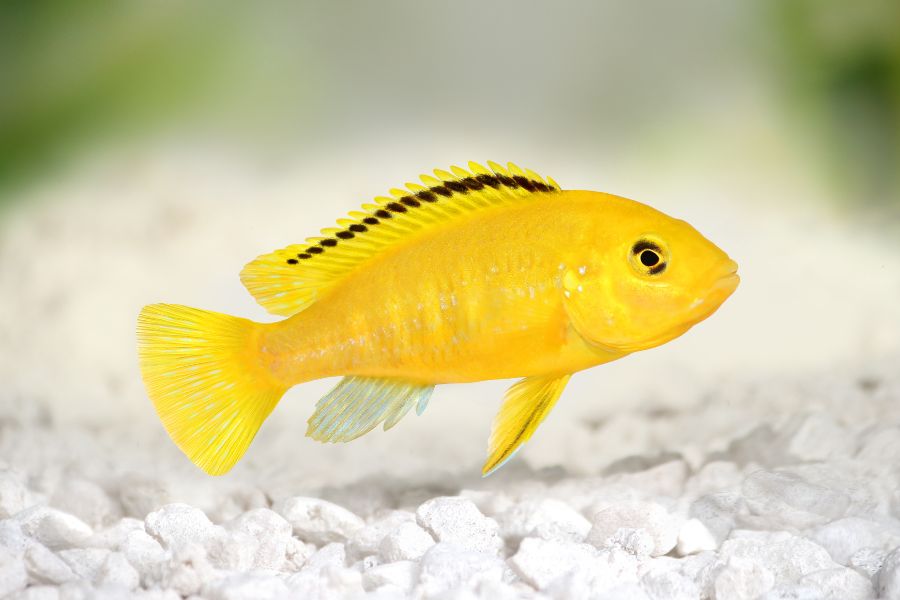
In that case, what you want to look for is an egg-like spot on the anal fins that only the males have. Female yellow labs do not have egg-like spots.
These egg-like spots attract females during breeding because of how similar they are to their eggs.
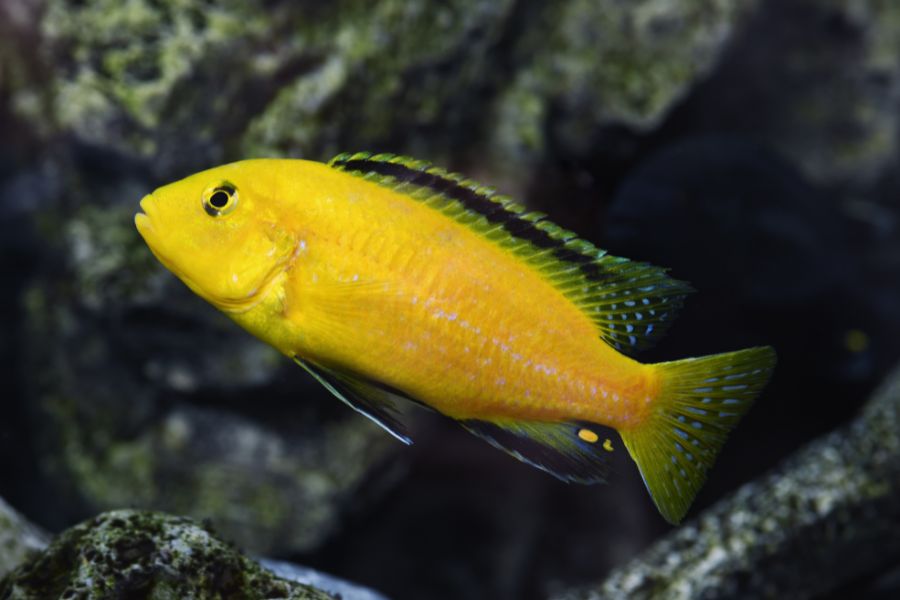
Once the female gets closer to putting the egg-like spot into their mouth, the male ejaculates into the female’s mouth, which is how the eggs get fertilized. This is how all Mbuna cichlids reproduce.
The 21 days is enough for the eggs to develop and the fry to hatch.
For better breeding results, try to keep the male-to-female ratio at one male with at least 2 – 3 females in a breeding tank.
Also, water conditions are more crucial during this period, ensuring the water quality and parameters are ideally stable throughout. Below are the best conditions for breeding:
- Temperature: 75 – 80 degrees Fahrenheit
- Diet: High Vegetable Diet, fewer proteins/meats diet (good foods include fry fish and fry groundfish flakes)
- Water pH levels: Above 7.8, the ideal is between 8.0 – 8.8
- Water Hardness: semi-hard between 18 – 20 DH
Also Read:
- Severum Cichlid: Types, Care, Tank Mates
- Bolivian Ram Cichlid: Care, Diet & Tank Mates
- Red Zebra Cichlid Care: All You Need To Know
- Red Devil Cichlid: Size, Tank Mates & Aggression
- Giraffe Cichlid (Venustus Cichlid)
- African Cichlid Peacocks
Summing Up
Consider a few things when buying a yellow lab cichlid. First of all, ensure the new fish (as well as its tank mates) does not have lesions, weird growths, and other physical abnormalities like white spots on the fish’s body.
Since the biggest selling point of the yellow lab is its bright color, you also want to ensure it does not look orange-like or faded.
A healthy yellow lab will have a bright yellow body with black-tipped fins. Please stay clear of any yellow lab with faded colors and other color morphs.
